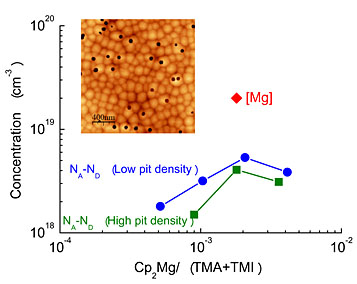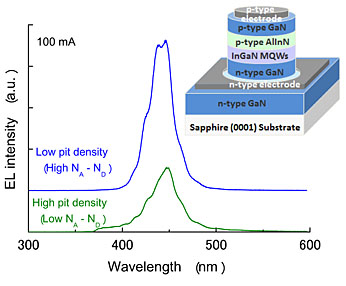Raphaël Butté*, and Nicolas Grandjean*
Materials Science Laboratory,
*Ecole Polytechnique Fédérale de Lausanne
Among III-nitride semiconductors, AlInN is the only ternary
alloy that can be grown lattice-matched to GaN at an In composition of
17 % [1]. Lattice-matched AlInN/GaN heterostructures should be free from
cracks, strain-driven composition inhomogeneities, and strain-related defects,
which are limiting the performance of ultraviolet/visible light-emitting
diodes (LEDs) and laser diodes (LDs) when using conventional lattice-mismatched
AlGaN/GaN or InGaN/GaN heterostructures. In addition, an AlInN/GaN structure
has a large bandgap discontinuity and a large refractive index contrast
even at the lattice-matched condition [1], which leads to strong carrier
and optical confinements. Thus, AlInN/GaN structures are expected not only
to improve the device properties but also to increase the design flexibility
for novel III-nitride devices.
Doping control of AlInN lattice-matched to GaN is crucial
for device applications. However, non-intentionally doped AlInN has so
far shown n-type conduction with high residual donor concentration, which
is a significant obstacle to p-type doping as well as to intentional n-type
doping. To reduce the residual donor concentration, we grew AlInN under
an In-rich condition to benefit from the In surfactant effect. Then, n-type
conduction of AlInN was intentionally controlled by Si doping. On the other
hand, we found that one of the compensating defects for p-type doping is
related to the presence of surface pits. By decreasing the pit density,
p-type AlInN was successfully obtained by Mg doping (Fig. 1) [2].
Using p-type AlInN, we fabricated InGaN/GaN multiple
quantum wells (MQWs) LEDs. The LEDs show light emission at a wavelength
of 445 nm, which corresponds to electron-hole recombinations occurring
in the InGaN/GaN MQWs (Fig. 2). This confirms the efficient hole injection
from the p-type AlInN layer to the MQWs. The achievement of p-type as well
as intentional n-type AlInN will open further new possibilities for III-nitride
devices.
[1] J.-F. Carlin and M. Ilegems, Appl. Phys. Lett. 83 (2003) 668.
[2] Y. Taniyasu, J.-F. Carlin, A. Castiglia, R. Butté, and N. Grandjean, Appl. Phys. Lett. 101 (2012) 082113.
 |
 |
|||||
|
|